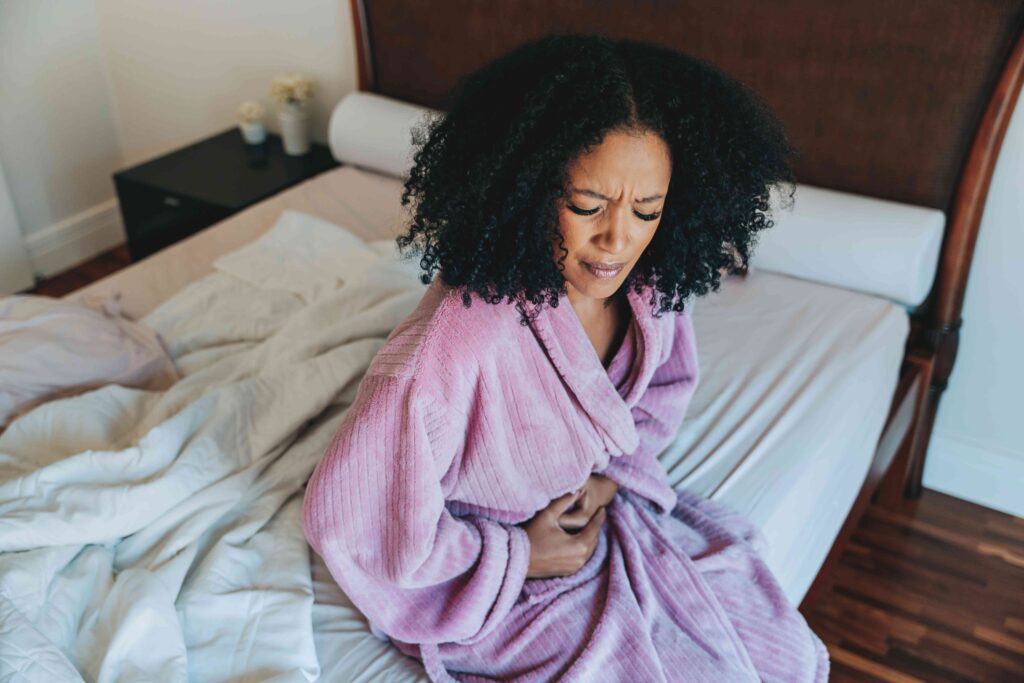:max_bytes(150000):strip_icc():format(jpeg)/health-GettyImages-2159352699-172595c64a044c28a81891b6000b031d.jpg)
Erosive gastritis occurs when inflammation gradually damages the stomach lining, causing shallow breaks (called erosions) and ulcers.
People with erosive gastritis experience symptoms like burning stomach pain, nausea, vomiting, and loss of appetite. If erosions or ulcers bleed, symptoms can include black or tarry stool, fatigue, shortness of breath, and vomiting blood.
Treatment options for erosive gastritis are available. Medications can help reduce stomach acid production, and procedures can stop internal bleeding if needed.
There are two types of erosive gastritis: acute (short-term) and chronic (long-term). Healthcare providers classify the types based on how quickly the condition develops and how long the inflammation persists.
Acute Erosive Gastritis
Acute erosive gastritis develops suddenly when substances like alcohol, nonsteroidal anti-inflammatory drugs (NSAIDs), or cocaine irritate and damage the stomach lining. The length of the condition depends on when diagnosis occurs and on treatment effectiveness. Most people heal within a month.
Stress gastritis is a subform that develops when physical stress from critical illness or injury, such as severe burns or sepsis, reduces blood flow to the stomach, making it more vulnerable to damage from stomach acids.
Chronic Erosive Gastritis
Chronic erosive gastritis is a long-lasting form that develops gradually over time. With this type, inflammation can persist for months or years, damaging the stomach lining.
The most common causes are persistent use of nonsteroidal anti-inflammatory drugs (NSAIDs) and continuous alcohol consumption. Viral infections (e.g., cytomegalovirus), radiation exposure, and underlying digestive disorders like Crohn’s disease can also lead to chronic erosive gastritis.
Erosive gastritis symptoms vary depending on the severity of damage to the stomach lining and whether ulcers or erosions are causing bleeding in the stomach. Mild erosive gastritis may not cause any symptoms.
When the condition progresses and symptoms develop, you may experience:
- Abdominal pain or burning
- Nausea and vomiting
- Loss of appetite
- Feeling full too quickly when eating
- Bloating or feeling uncomfortably full after a meal
- Unintentional weight loss
When erosive gastritis wears away the stomach lining and causes ulcers or erosions that bleed, symptoms may worsen and you might develop:
- Black, tarry stools
- Red or maroon blood in stool
- Abdominal pain and cramping
- Fatigue
- Weakness
- Shortness of breath
- Lightheadedness
- Red blood in vomit or vomit that resembles coffee grounds
Erosive gastritis develops when inflammation damages the stomach lining, leading to ulcers (open sores) and shallow breaks (erosions). The most common causes of erosive gastritis are substances that irritate the stomach’s protective lining, including:
- Nonsteroidal anti-inflammatory drugs (NSAIDs)
- Alcohol
- Cocaine
About 5% of people with critical illness or severe injury also develop erosive gastritis.
In critical situations, the body prioritizes blood flow to essential organs like the brain and heart, often reducing circulation to the stomach and digestive tract. Limited blood supply weakens the stomach’s protective lining, making it vulnerable to damage from digestive acids and leading to ulcers and erosions.
Common causes of stress-associated erosive gastritis include:
- Sepsis
- Severe burns
- Head injury or trauma
- Critical illness
- Use of mechanical ventilation (a machine that helps people breathe)
Risk Factors
Certain factors can increase the likelihood of developing erosive gastritis, including:
- Age: Middle-aged and older adults are more likely to develop erosive gastritis.
- Chronic NSAID use: Long-term use of nonsteroidal anti-inflammatory drugs, such as Advil (ibuprofen), Aleve (naproxen), and Bayer (aspirin), increases the risk of stomach irritation and erosion.
- Heavy or prolonged alcohol consumption: Alcohol irritates and weakens the stomach lining over time.
- Infections: Bacterial, viral, and fungal infections that affect the gastrointestinal tract can increase the risk in people with weakened immune systems.
- Severe illness or injury: Critical conditions like traumatic injury, sepsis, or surgery can reduce blood flow to the stomach, increasing the risk of erosive gastritis.
- Autoimmune conditions: Certain autoimmune disorders, including Crohn’s disease and sarcoidosis, may contribute to inflammation in the stomach lining.
- Cancer treatment: A history of radiation therapy or chemotherapy can weaken and damage the stomach lining.
During your appointment, your healthcare provider may ask questions about your symptoms, when they developed, which medications you take, and how much alcohol you consume. Your healthcare provider may also order diagnostic tests to help detect inflammation, bleeding, and the extent of stomach damage.
These tests may include:
- Blood test: Identifies infection and inflammation markers and checks for anemia
- Stool test: Takes a sample of your poop to check for blood in the stool, which is a sign of stomach bleeding
- Upper GI endoscopy: Uses a flexible tube with a tiny camera to view the stomach and identify areas of erosion or ulceration
- Biopsy: Removes a small tissue sample from the stomach lining and views it under a microscope to check for inflammation and other abnormalities
Treatment for erosive gastritis focuses on reducing inflammation in the stomach lining to manage symptoms, promote healing, and prevent further erosion. Depending on the underlying cause and severity of erosive gastritis, your treatment plan may include lifestyle changes, medications, or medical procedures.
Lifestyle Changes
Lifestyle changes can help manage symptoms of erosive gastritis and help your stomach lining heal. Your healthcare provider may recommend:
- Make dietary adjustments: Avoid spicy, sugary, acidic, and greasy foods that can irritate the stomach lining, and opt for foods that are gentle on the stomach, such as white bread, rice, oatmeal, and cooked vegetables.
- Avoid or quit smoking and drinking alcohol: Tobacco and alcohol can irritate the stomach lining and prevent or slow the healing of ulcers and erosions.
- Modify NSAID use: If you take NSAIDs, your healthcare provider may recommend switching to alternative pain relievers to avoid further stomach lining damage.
Medications
Medications that help control stomach acid levels are a mainstay treatment for erosive gastritis. Your healthcare provider may prescribe:
- Proton pump inhibitors (PPIs): These protect the stomach lining and promote healing by reducing stomach acid production. PPIs include Prilosec (omeprazole), Nexium (esomeprazole), Prevacid (lansoprazole), and Protonix (pantoprazole).
- H2 blockers: These over-the-counter (OTC) medications like Pepcid (famotidine), Axid (nizatidine), and Tagamet (cimetidine) reduce stomach acid production to control symptoms and promote healing.
- Sucralfate: Carafate (sucralfate) is a medicine that creates a protective barrier over damaged areas of the stomach lining. It acts as a shield against stomach acids, allowing the tissue to heal without further irritation.
Medical Procedures
If erosive gastritis is causing stomach bleeding and severe blood loss, your healthcare provider may recommend a medical procedure to stop the bleeding.
- Endoscopic hemostasis: During this procedure, your healthcare provider will use an endoscope (a flexible tube with a camera) to locate the source of bleeding and apply treatments to stop the bleeding. Depending on the severity of the bleeding, your provider may use thermal coagulation (using heat to stop bleeding), endoscopic clips (to close and seal the erosion), or injection therapy (injecting medicine into the bleeding area).
- Surgery: Although rare, surgery is sometimes required when other treatments fail to stop stomach bleeding.
It’s not always possible to prevent erosive gastritis, but certain lifestyle habits can help lower your risk of developing the condition. You may try to:
- Limit NSAID use
- Quit or avoid smoking
- Avoid alcohol or drink in moderation
- Manage stress levels with hobbies you enjoy, relaxation techniques, and breathing exercises
- Eat smaller, more frequent meals throughout the day
- Reduce your intake of overly spicy, sugary, or fatty foods
Untreated erosive gastritis can lead to other health problems, including:
- Gastrointestinal bleeding: Erosion of the stomach lining increases the risk of bleeding, which may appear as blood in vomit or stools and can lead to anemia.
- Anemia: Chronic bleeding from erosive gastritis reduces red blood cell counts, leading to anemia and symptoms like fatigue, weakness, headaches, irritability, loss of appetite, and shortness of breath during physical activity.
- Pyloric stenosis: Chronic inflammation and stomach ulcers can cause scar tissue to form in the stomach, narrowing the passage between the stomach and small intestine, which can obstruct food passage and cause vomiting and abdominal pain.
- Perforation: Untreated stomach ulcers can lead to holes in the stomach lining (known as perforation), allowing stomach contents to leak into the abdominal cavity. This can cause peritonitis, a life-threatening infection that requires prompt treatment.
Erosive gastritis causes inflammation that damages the stomach lining, leading to ulcers and erosions. Long-term NSAID use and excess alcohol consumption are the most common causes of erosive gastritis.
If you develop this condition, common symptoms include abdominal pain, nausea, and loss of appetite. Treatments like lifestyle changes, medications, and procedures can help heal your stomach lining and prevent complications.













